In the Lands of the Aztecs and the Incas
The Spanish conquest of the Aztec and Inca empires in the early sixteenth century gave Spain access to the most wealthy, urbanized, and densely populated regions of the Western Hemisphere. Within a century and well before the British had even begun their colonizing efforts in North America, the Spanish in Mexico and Peru had established nearly a dozen major cities; several impressive universities; hundreds of cathedrals, churches, and missions; an elaborate administrative bureaucracy; and a network of regulated international commerce.
Change
What was the economic foundation of colonial rule in Mexico and Peru? How did it shape the kinds of societies that arose there?
The economic foundation for this emerging colonial society lay in commercial agriculture, much of it on large rural estates, and in silver and gold mining. In both cases, native peoples, rather than African slaves or European workers, provided most of the labor, despite their much-

On this economic base, a distinctive social order grew up, replicating something of the Spanish class and gender hierarchy while accommodating the racially and culturally different Indians and Africans as well as growing numbers of racially mixed people. At the top of this colonial society were the male Spanish settlers, who were politically and economically dominant and seeking to become a landed aristocracy. One Spanish official commented in 1619: “The Spaniards, from the able and rich to the humble and poor, all hold themselves to be lords and will not serve [do manual labor].”13 Politically, they increasingly saw themselves not as colonials, but as residents of a Spanish kingdom, subject to the Spanish monarch, yet separate and distinct from Spain itself and deserving of a large measure of self-
But the Spanish minority, never more than 20 percent of the population, was itself a divided community. Descendants of the original conquistadores sought to protect their privileges against immigrant newcomers; Spaniards born in the Americas (creoles) resented the pretensions to superiority of those born in Spain (peninsulares); landowning Spaniards felt threatened by the growing wealth of commercial and mercantile groups practicing less prestigious occupations. Spanish missionaries and church authorities were often sharply critical of how these settlers treated native peoples. While Spanish women shared the racial privileges of their husbands, they were clearly subordinate in gender terms, unable to hold public office and viewed as weak and in need of male protection. But they were also regarded as the “bearers of civilization,” and through their capacity to produce legitimate children, they were the essential link for transmitting male wealth, honor, and status to future generations. This required strict control of their sexuality and a continuation of the Iberian obsession with “purity of blood.” In Spain, that concern had focused on potential liaisons with Jews and Muslims; in the colonies, the alleged threat to female virtue derived from Native American and African men.
From a male viewpoint, the problem with Spanish women was that there were very few of them. This demographic fact led to the most distinctive feature of these new colonial societies in Mexico and Peru—
Mestizos were largely Hispanic in culture, but Spaniards looked down on them during much of the colonial era, regarding them as illegitimate, for many were not born of “proper” marriages. Despite this attitude, their growing numbers and the economic usefulness of their men as artisans, clerks, supervisors of labor gangs, and lower-
At the bottom of Mexican and Peruvian colonial societies were the indigenous peoples, known to Europeans as “Indians.” Traumatized by the Great Dying, they were subject to gross abuse and exploitation as the primary labor force for the mines and estates of the Spanish Empire and were required to render tribute payments to their Spanish overlords. Their empires dismantled by Spanish conquest, their religions attacked by Spanish missionaries, and their diminished numbers forcibly relocated into larger settlements, many Indians gravitated toward the world of their conquerors. Many learned Spanish; converted to Christianity; moved to cities to work for wages; ate the meat of cows, chickens, and pigs; used plows and draft animals rather than traditional digging sticks; and took their many grievances to Spanish courts. Indian women endured some distinctive conditions as Spanish legal codes generally defined them as minors rather than responsible adults. As those codes took hold, Indian women were increasingly excluded from the courts or represented by their menfolk. This made it more difficult to maintain female property rights. In 1804, for example, a Maya legal petition identified eight men and ten women from a particular family as owners of a piece of land, but the Spanish translation omitted the women’s names altogether.15
But much that was indigenous persisted. At the local level, Indian male authorities retained a measure of autonomy, and traditional markets operated regularly. Both Andean and Maya women continued to leave personal property to their female descendants. Maize, beans, and squash persisted as the major elements of Indian diets in Mexico. Christian saints in many places blended easily with specialized indigenous gods, while belief in magic, folk medicine, and communion with the dead remained strong. Memories of the past also endured. The Tupac Amaru revolt in Peru during 1780–
Thus Spaniards, mestizos, and Indians represented the major social categories in the colonial lands of what had been the Inca and Aztec empires, while African slaves and freemen were less numerous than elsewhere in the Americas. Despite the sharp divisions among these groups, some movement was possible. Indians who acquired an education, wealth, and some European culture might “pass” as mestizo. Likewise, more fortunate mestizo families might be accepted as Spaniards over time. Colonial Spanish America was a vast laboratory of ethnic mixing and cultural change. It was dominated by Europeans, to be sure, but with a rather more fluid and culturally blended society than in the racially rigid colonies of British North America.